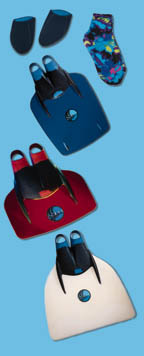
Freedive!
CHAPTER
EXCERPTS
|
 |
FREEDIVE!
by Terry Maas and David SipperlyMonofins

Monofin swimmers, equipped with special front-mounted snorkels,
bear a striking likeness to marine mammals-especially dolphins, who must appreciate the
resemblance as well because the two often play together for hours.
In 1967, Siberian Russians invented the monofin by riveting two traditional rubber fin
pockets to a single blade of metal. For almost two decades the Russians would dominate the
sport of fin swimming, one aspect of which is a 50-meter underwater race.
Monofins provide freedivers with a powerful yet graceful alternative to the standard pair
of fins. They are used for serious fin swimming competitions as well as for open-ocean
excursions. We'll begin this chapter with comments from Mike Gower, president of the
Underwater Society of America and Director of Fin Swimming Competitions. Then we'll
profile two expert amateur monofin swimmers: competitor and coach Peppo Biscarini, for his
contributions to the sport and Theresa Villa, for her graceful interactions with marine
mammals.
Mike Gower talks excitedly about monofin swimming events. "Racing divers in the
50-meter apnea event generate an awesome 6-inch pressure-wave riding across the pool after
they pass underwater," he says. "The wave is shaped like a 'V' because the
fastest swimmers get center positions in the pool and form the tip of wedge-shaped
wave." Monofin-equipped swimmers routinely make 13-minute miles over the water in
long-distance races. Over or under the water, they're the world's fastest swimmers. Some
reach speeds of 7.5 miles-per-hour (12.2 kilometers-per-hour.)............

Current monofins employ fiberglass for the blade. Two-millimeters
thick at its base, the blade tapers to 0.72 millimeters at the tip. Subtle channels in the
center guide the water toward the back, away from the sides where it spills off uselessly.
A progressive taper encourages a laminar flow toward the back. Monofins are made in two
configurations, depending on their use. For long distances, swimmers prefer a flexible
blade. They use a somewhat shorter, stiffer blade for sprints............One day Theresa
spotted a strange looking single-bladed fin—a monofin—on the beach. She asked
its owner for a test ride. “It was an instant obsession,” she recalls.
“Putting on the trappings of a dolphin made me feel as if I had actually become
one.”
Competing with the monofin was a natural for Villa. In 1996, she won three national fin
swimming championship events and set three national records. Even more than she loves
competition, she treasures her dolphin friends. She frequently swims with the same pod and
recognizes individuals. She credits the monofin’s dolphin-like appearance as a key to
her dolphin interactions, but she’s quick to recognize the dolphin’s superior
speed and agility. “They choose to swim with me—it’s their decision,”
she says...........

Freediving with playful intelligent marine mammals is one of
nature’s all-time highs. When a wild group of animals invites you to join in their
games, you cannot resist. While filming Theresa and her friend Jennifer Veltmann for the
companion video to this book, Terry joined the two women in a dolphin game—”pass
the leaf.”
The first of six dolphin approached with a bright yellow leaf pinned firmly to its side
fin by water pressure. As it swam by, it flicked the leaf off with a pass to the dolphin
behind, which deftly juggled the leaf from its nose to its dorsal fin to its tail and
finally off to us.
Theresa picked up the leaf with her usual grace and speed and then swam with the playful
animals, enticing them with the leaf held between her fingers. The game finished its cycle
when Theresa dropped the leaf and another wild dolphin picked it up with its side fin.
What a rush!
It’s wonderful that successful amateur athletes such as Peppo and Theresa prize their
dolphin-swimming experiences above all others. It’s clear that the shape of the
monofin, its motion underwater and the impressive increase in speed it provides makes this
the ultimate dolphin-swimming accessory.
.
|


